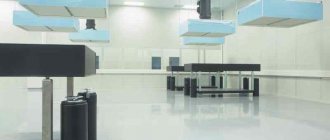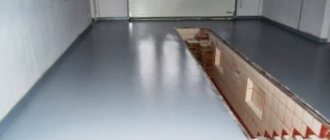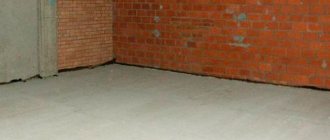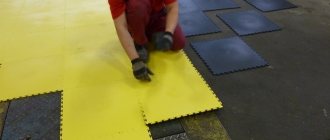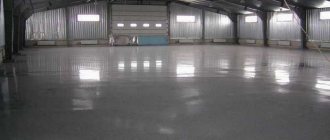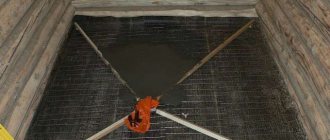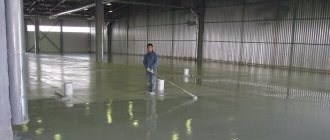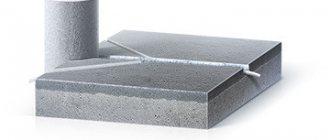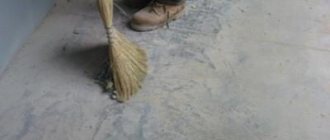Concrete floors with topping are particularly durable, which appears after rubbing strengthening additives into fresh concrete and coating with a membrane-forming varnish. These floors - they are also called industrial - do not need any protection, which is why they are extremely popular at industrial sites.
Concrete floors with topping
The use of topping significantly extends the service life of the concrete coating, as it increases strength, wear resistance and resistance to high temperatures. The surface does not deform over time even under mechanical stress, temperature changes, or contact with chemicals. substances, etc.
Floors with a hardened layer
In order for a concrete floor to successfully withstand mechanical loads, topping is added to the freshly poured mortar (five to six hours after leveling, and the cement must be at least grade three hundred and not have any additives), which results in a hardened coating. It is important that the preparation of the base (preparation of mortar, reinforcement, thickness) fully complies with SNiP and the previously drawn up project.
Toppings
The topping itself consists of the following components:
- plasticizers;
- high quality cement;
- fillers with dyes that provide resistance to mechanical damage and various colors.
Important information! Consumption depends on the planned load on the floor, although on average it varies between 3 and 9 kg/m².
Corundum topping Solidtop
The advantages of dust-free industrial floors include:
- high strength;
- ease of care;
- wear resistance;
- hygiene;
- affordable price (approximately 1.6 thousand rubles per 1 m² with a height of 8 cm);
- almost complete absence of dust;
- high installation speed;
- durability;
- heat resistance.
But there are also disadvantages, including:
- presence of seams;
- low resistance to chemicals;
- low maintainability.
| Specifications | Quartz | Corrund | Metal |
| Layer thickness | 2-3 mm | 2-3 mm | 2-3 mm |
| Strengthening period | 28 days | 28 days | 28 days |
| Pedestrian load | After 1 day | After 1 day | After 1 day |
| Light load (no more than 200 kg/cm2) | After 7 days | After 7 days | After 7 days |
| Compressive strength after 28 days of curing | not less than 80 MPa | not less than 85 MPa | not less than 90 MPa |
| Tensile bending strength after 28 days of curing | not less than 7 MPa | not less than 7 MPa | not less than 8.1 MPa |
| Maximum shrinkage | 0,09% | 0,09% | 0,09% |
| Bulk density of the mixture | 1846 kg/m3 | 1970 kg/m3 | 1920 kg/m3 |
| Maximum particle size of dry mixture | 3.2 mm | 3.2 mm | 3.2 mm |
| Abrasion on disk LKI-3M | 0.11 g/cm2 | 0.14 g/cm2 | 0.11 g/cm2 |
| Impact resistance | 20 kg/mm2 | 20 kg/mm2 | 20 kg/mm2 |
Polina Yavorskaya
Concrete flooring is an inexpensive and fairly durable coating that is widely used in warehouse, industrial, commercial and agricultural premises, as well as in garages, service centers, on loading platforms, etc.
But, unfortunately, the material is not without its shortcomings. Over time, brittle concrete begins to crumble and deteriorate.
The porous coating absorbs any liquid spilled on it, generates dust and does not look very presentable.
However, there is a technology that can significantly increase the wear resistance and strength characteristics of this popular floor, as well as increase its service life, and its name is topping coating.
Types of topping
Types of topping
Strengthening coating for concrete floors can be liquid or dry.
Topping
Liquid topping
This type of topping consists of inorganic compounds that dissolve in water. When it is applied to the floor, these compounds enter approximately 0.5 cm into the pores of the material, where the calcium carbonate and free lime in the mixture cause a reaction. As a result, insoluble compounds appear, and they, in fact, are the same sealants.
Important information! The liquid product can be applied to both fresh concrete and old concrete.
The use of this strengthening technology allows the floor to withstand significant loads in buildings with low humidity levels. But it is not practical to use it (the technology) under high dust requirements or in the presence of aggressive environments.
Dry topping
Dry topping
Dry compacting a concrete floor uses the same substance that is used to make concrete—in most cases, Portland cement. Due to the similarity of the compositions of these materials, the adhesion of the hardener and the base increases. The load that the top layer can withstand exceeds 70 MPa, and all parameters are significantly improved (strength, resistance to various external influences, wear resistance increase).
Topping TopHard Corundum
The service life of concrete pavement increases to approximately fifteen years. The topping is applied exclusively to a freshly laid and leveled surface, as a result - it looks more aesthetically pleasing and is practically free of dust.
Reinforcers (materials such as iron filings, quartz and corundum) improve the performance of the floor and are selected according to the requirements for it.
- If average loads on the floor are planned, then a topping that includes quartz is used.
- If the loads are high, then material based on corundum filler is used.
- And if the loads are very high, then the topping should be with iron filings.
Important information! Today there are about ten topping colors, so everyone can choose the most suitable option for themselves.
Universal topping floor - scope of application and installation features
In industrial areas, manufacturing plants have certain requirements for flooring. They must be ultra-strong, resistant to abrasive wear, mechanical shock and chemicals, and also fireproof. All these qualities are possessed by topping floors - concrete coverings with a reinforcing top layer.
Application of liquid hardener
There should be no problems with liquid topping, since the application procedure is extremely simple. First, the surface is cleaned of dirt and dust, various potholes and cracks are filled with repair mortar. Then the hardener is applied. This can be done in one of three possible ways:
- sprayer;
- roller;
- spilling of the hardener from the container and uniform distribution over the surface.
Important information! Work must be carried out at a temperature of 5-35ᵒC. Those areas that strongly absorb the substance are treated additionally.
After about an hour, the hardener hardens, so it needs to be moistened so that it penetrates the pores without residue. When the material polymerizes, its residue is washed off and removed from the concrete floor. Next, the water is removed, for which you can use a dry rag or compressed air.
Important information! The floor cannot be used earlier than 24 hours after applying the topping. Full operation is possible only after a week.
During the process, you should use personal protective equipment - goggles, rubber gloves, work shoes. It is also worth remembering that the liquid topping is fire and explosion proof.
floor topping
Scheme of a concrete floor with topping
Application
Topping is most often used in the construction and renovation of buildings and facilities where floors are subject to heavy and constant loads.
Topping is used in both residential and industrial construction.
The category of industrial buildings includes factories, terminals, workshops with heavy machines and installations. But manufacturers do not recommend using toppings in the production of chemicals such as acids.
Among civil objects it is worth noting apartment buildings, public institutions with a large flow of people, stadiums, airports, hypermarkets, train stations, parking lots, shopping and entertainment centers, large refrigerators.
If desired, it can be used in private construction to give the floor extra strength.
Adding dry topping
The technology for strengthening the floor in this case will look something like this.
Stage 1. Reinforcement and pouring of concrete.
Stage 2. Compacting the floor.
Stage 3. Sanding. The concrete is rubbed until a perfectly flat surface is obtained. After this you can start applying the topping.
Sanding floor screed
Important information! The hardener is applied to the freshly laid surface using a special dosing cart, after which the surface is rubbed with a concrete finishing machine.
Stage 4. First application of the material. After grouting the surface, 2/3 of the entire mixture is distributed with a trolley onto the grouted floor and leveled with a special leveler so that the layer thickness is uniform. First, areas near walls, doorways and columns are filled.
Distribution trolley
Stage 5. First grouting. First, the same places that were filled in first are rubbed down. Grouting is carried out on a disk after the hardener has absorbed moisture from the base, and continues until the material is completely saturated with “cement laitance” and is combined with the surface. Grouting work should be calculated in such a way that the floor surface is not additionally wetted.
Stage 6. Re-application of hardener. At the end of the grouting work, the remaining topping is applied so that it is saturated with moisture from the “milk” until the water evaporates.
Stage 7. Re-grouting is carried out as soon as the material is saturated with moisture. The surface is rubbed with discs until the topping is saturated with “cement laitance”.
Step 8: Once the concrete has hardened, it is troweled using paddle trowel blades. It is important that the blades do not bury themselves in the material. The treatment is carried out at least three times and each time the blades rise a little higher. The result should be a mirror surface.
Grout
Stage 9. When the concrete has gained strength, its surface is treated with curing, for which you can use either a sprayer or a roller. After this, the topping is covered with film to prevent color change and dirt.
curing
Curing
Shrinkage joints are cut within two days, and after two weeks they can be filled with sealant. Full use of the concrete floor is possible only 28 days after filling the topping.
Scheme of a concrete floor with topping
Cutting and filling seams
Professionals will quickly lay the floor
On a frozen screed filled in the described way, there can be 3 types of seams:
- Insulating.
- Shrinkage.
- Structural.
Insulation joints are installed to prevent the transfer of deformation from the walls to the screed. They are made along the perimeter of the building by laying insulating material along all existing structures.
Shrinkage seams prevent the high screed from cracking randomly. They create the necessary slack in the internal plane. Such seams are formed along the boundaries of the cassettes, and the smaller the rectangle, the less likely it is for random cracking to occur. Shrinkage joints are cut along the boundaries of the cassettes 2 days after concreting. The thickness of the seam is 1/3 of the thickness of the screed.
Structural joints are cut where the boundary of the daily concrete pour ends. They perform the same function as shrinkage ones, allowing horizontal rather than vertical movements to form.
Seam sealing
After cutting, the seams must be sealed. To do this, the gap space is first thoroughly dust-free, and a cord 40% thicker than the width of the seam is laid at its bottom. Then the entire hollow space is filled with a polymer primer. When it dries, the top of the seam is covered with sealant.
Often asked
Does strengthening the surface layer make it possible to use cheaper grades of cement for concrete?
Yes, this is possible, but most mixture manufacturers guarantee the strength of the top layer only if the floor mixture is prepared from cement grade no lower than M350.
Is it necessary to wet the dry topping after application?
As a rule, this is not necessary; the moisture stored in the concrete is sufficient to wet the topping. You can add water only if the concrete base has been left standing and the layer does not darken within 2-3 hours.
How long does it take for the topping to harden?
In terms of this indicator, it is similar to concrete; by the time the floor reaches full strength, the protective layer will also acquire the specified characteristics.
Does the loss of gloss that the floor acquired after coating with curing mean that the protective characteristics of the topping have deteriorated?
No, this means that the polymer film on the surface has worn out. It served to reduce water evaporation and does not have any effect on the strength of the topping.
Are there any special requirements for indoor climate parameters during work?
As when working with concrete, there are no specific requirements, except for a non-zero (or better, in the range of 5-30 ° C) temperature.
Mixture composition
The basis of the material is portand cement. It has a powdery texture. To increase the level of strength of the concrete surface, various chemical additives and fine-grained fillers are mixed into the composition.
Reinforcers are divided into several types depending on the material that is added as a filler.
Quartz topping
Corundum
Metallized
This hardener is considered the highest quality and most durable. Metal shavings are mixed into its composition. The cost of this topping is higher than other varieties.
When pouring concrete for residential construction, such topping is not used.

